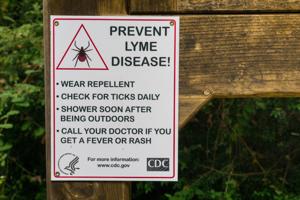New model from University of Illinois could help limit spread of Lyme disease

(The Center Square) – A new model developed at the University of Illinois could help limit the spread of Lyme disease.
Scientists at the University of Illinois Urbana-Champaign studied both reported cases of the disease as well as the migration of the black-legged tick, which can the bacterium that causes Lyme disease, an infection that can affect the nervous system, heart, and joints.
“Lyme disease was apparently spreading to new areas,” said Dr. Brian Allan, an entomology professor who led the research. “This is an interesting biological problem because we know that the ticks that transmit Lyme disease cannot move long distances on their own. It seemed very probable to us that wildlife was playing a role in their dispersal.”
Researchers used two major sources of data in their work, tracking human Lyme disease incidents as reported to the CDC as well as scientific studies conducted in the Midwest that looked for the ticks that transmit the Lyme pathogen.
“We found that three landscape features were really predictive of the arrival of Lyme disease,” Allan said. “The amount of forest cover in the county, proximity to a county where Lyme disease is already established, and the idea that riverways are kind of these conduits for dispersal of Lyme disease.”
The model predicts seven Illinois counties could be invaded by the black-legged tick this year, namely Kane, Whiteside, Adams, Pike, Scott, Calhoun, and Moultrie.
“Education efforts tend to be one of our best strategies for preventing Lyme disease cases,” Allan said. “Being able to tell people that there’s Lyme disease risk in an area and that they should take preventative measures.”
In addition to the seven counties in Illinois, the researchers identified 35 additional counties in the Midwest where black-legged ticks are likely to be detected by the end of 2021.
The model revealed is there are probably a number of counties in the Midwest where Lyme disease is established but hasn’t been reported yet. Allan says the information also could be very useful for physicians in those areas.
“That can actually inform decision-making by physicians,” Allan said. “Lyme disease can be challenging to diagnose, and so knowing that there are ticks nearby that can transmit Lyme disease to patients can help physicians with those diagnoses.”
If you’re in an area where the tick is present, Allan recommends using repellents and performing tick checks after being in the woods.
“Lyme disease is effectively an invasive disease in Illinois because the tick and the pathogen have become established here,” Allan said. “For us as scientists, it was fortunate we were working where this exact invasion process was playing out. It allowed us to document what was happening in a familiar landscape and then extend our findings throughout the region where similar things were occurring in other states nearby.”
Disclaimer: This content is distributed by The Center Square

